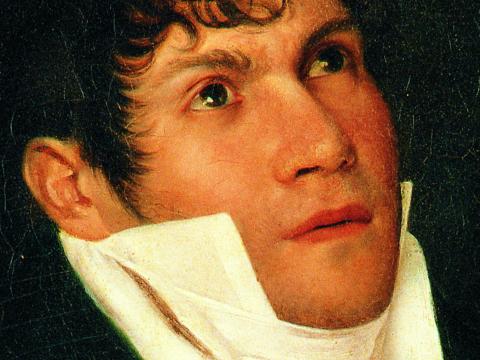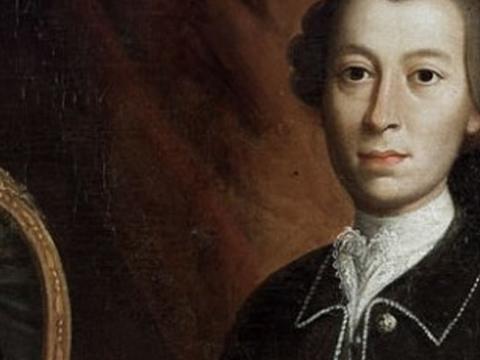Historical Figures
Valeria Moriconi
Valeria Abruzzetti was born in Jesi on the 15th of November, 1931. She took the surname Moriconi after her early and short marriage with the painter Aldo Moriconi. Her passion for the stage blossomed just in her hometown, where she made her début at 16 with an amateur company.
After moving to Rome with her husband Aldo, in 1953 she started to work in cinema playing minor roles. In 1957 she made her professional stage début thanks to the Neapolitan actor, screenwriter and author Edoardo De Filippo, who discovered her and made her play the leading role in his comedy "De Pretore Vincenzo". In the '60s she joined the company called "Compagnia dei Quattro" together with Glauco Mauri, Mario Scaccia and the director Franco Enriquez with whom she had a professional and sentimental partnership. The company staged important plays by classical and contemporary authors.
She gave some memorable performances as a mother, which confirmed her talent and earned her great success in the '80s and '90s: "Emma B vedova Giocasta” by Savinio, “Filumena Marturano” by De Filippo and “Medea” by Euripides.
She came back seriously ill to Jesi, where she died on the 15th of June, 2005.
Rafael Sabatini
He was born in Jesi on the 29th of April, 1875. His father was from Jesi and his mother Anna Jellery was English; they were both opera singers and became then teachers. When he was still a child he moved to Milan with his family and then emigrated to Switzerland, to Portugal and finally to England, where he began his career as a journalist and started to write historical and adventure novels.
In 1904 he published the novel "The Tavern Knight", the first of a long series of narrative, theatre and non-fiction works. In 1921 "Scaramouche" came out, a swashbuckling novel set during the years of the French Revolution, which earned him worldwide success. The same happened the following year with "Captain Blood". Another successful novel was "The sea hawk", written in 1915 and printed afterwards. Many of his novels were adapted for the screen: "Captain Blood" in particular, directed by Michel Curtiz in 1935, featuring an unforgettable performance by Errol Flyn and Olivia de Havilland, "The sea hawk" directed again by Michel Curtiz in 1940, and "Scaramouche" directed by George Sidney in 1952, with Steward Granger, Eleanor Parker and Janet Leigh.
He died in Switzerland, in Adelboden, on the 13th of February, 1950.
Adriano Colocci
Born in Jesi on the 7th September, 1855, Adriano was Antonio's son and joined his family name to the maiden name of his mother Enrichetta Vespucci, who was a descendant of the famous navigator Amerigo Vespucci. He had multiple interests and loved adventures, was a researcher, an explorer, an ethnographer and an anthropologist: his essay "The Gypses - History of a nomadic people" written in 1889 is up to now a landmark in romanology. He was also a diplomat, a journalist and a politician. After studying law, he became a teacher of political and statistic economy at Camerino University, which he left after two years to devote himself to politics. In 1883, as council member of the province, he founded in Ancona the paper "Il Popolo Marchigiano" at his own expense.
In 1885 he joined the Rumeli revolt against Serbia, contributing to the birth of the Principality of Bulgaria. Later on he carried out diplomatic missions in the Balkans and in Constantinople, travelling through Egypt, Palestine and Lebanon.
In 1890 he set out on an exploration journey to South America, sailing up the Parana river. He left detailed reports about his journeys, especially in a diary left unpublished, writing also a lot about social and political issues.
He died in Rome on the 31st of March, 1941.
Antonio Colocci
Coming from the Colocci lords of Staffolo, the Colocci family had been well known in Jesi since the 14th century and its members were among the most influential figures of the town oligarchy.
They were admitted among the Roman aristocrats in 1505, obtained the earldom of Rotorscio in 1685 and the marquisate of the the Holy Roman Empire in 1752. Antonio Colocci was born in Jesi on the 25th of September, 1820. He took part in the Risorgimento events since the Roman Republic, of which he was deputy to the Constituent Assembly. After the restoration of the papal government, he emigrated as an exile to Tuscany, where he lived for some time. Here he got married to Enrichetta Vespucci in 1853.
After he came back to Jesi promising not to carry out political activities, he was involved in the 1859 failed insurrectionary attempt and had to flee again to Florence, where his wife and children Adriano and Maria Cristina joined him. He was Member of Parliament in the 8th and 9th term and was senator of the Reign since 1879.
He passed away in Jesi on the 4th of April, 1908.
Gaspare Spontini
Born in Maiolati on the 14th of November 1774, he was sent in his teens to live in Jesi at his uncle's Don Giuseppe Spontini, who was the parish priest of the church Santa Maria del Piano. In Jesi he studied in the seminary and when he showed a natural bent for music, he started to take the first music lessons. In 1793 he moved to Naples and studied in the Conservatorio della Pietà de' Turchini, where he started to compose his first works, cantatas and oratorios.
After leaving his studies, he went to Rome where he earned immediately a resounding success with the opera "Li puntigli delle donne" (The Stubborness Of Women) in 1796. In 1803 Spontini established himself in Napoleon's Paris, and in 1807 he composed his great masterpiece, the tragédie lyrique "La Vestale", which clearly represents neoclassical musical style and taste. The success earned him the appointment of Director of the Italian Opera and the favours of the restored monarch Louis XVIII. In the meanwhile in 1811 he married Marie Catherine Celeste Erard, daughter of a famous piano maker.
Invited to Berlin at the court of Frederick William III, in 1820 he was appointed to the post of Court composer and general musical director of the Royal Opera. In 1821 he presented to the German audience a renewed version of "Olympe" with striking success, and in 1829 "Agnese von Hohenstaufen", a model for the following heroic historical melodramas.
When Frederick William III died, he fell into disgrace. He left Berlin and in 1850 he retired for good to his native vilage, Maiolati, where he died on the 24th of January, 1851. In honour of this great composer, his hometown added "Spontini" to its original name "Maiolati".
GIovanni Battista Pergolesi
He was born on the 4th of January 1710 in Jesi. He took the name Pergolesi from his grandfather Francesco, a craftsman from Pergola, who moved to Jesi in 1635. He soon showed a natural bent for music and took his first lessons from the local musician Francesco Santi, the maestro di cappella of the Duomo. Thanks to marquis Cardolo Maria Pianetti he was admitted to the Conservatorio dei Poveri di Gesù Cristo, a conservatoire in Naples, where he moved and remained to study for five years.
He became famous in Europe thanks to "La serva padrona" (The servant mistress), intermezzo of his opera seria "Il prigionier superbo" (The proud prisoner) dated 1733. This intermezzo gave origin to the Italian opera buffa and to the French comic opera, becoming a very popular work in its own right. Among his works are the commedia musicale "Lo frate 'nnamorato" (The monk in love) dated 1732 and "Livietta e Tracollo", another intermezzo of the opera "Adriano in Siria" (Adrian in Syria) dated 1734. In 1734 he moved to Rome where he composed the drama "L'Olimpiade" (Olympiad) which was performed in January 1735 on a libretto by Pietro Metastasio and is considered the most perfect among his opera seria.
Back to Naples, he composed the dramma in musica "Flaminio". With his health worsening, undermined by tuberculosis for long years, he decided to move to Pozzuoli to be nursed in a monastery of Franciscan Friars. Here in 1736, in the last months of life, he composed his sacred music masterpiece "Stabat Mater". He died on the 16th of March 1736 in the Capuchin monastery and was buried in the pauper's grave of the Cathedral in Pozzuoli.
Frederick II
In December 1194, Constance of Hauteville, who was travelling through the March of Ancona towards Sicily to reach her husband Henry VI, Holy Roman Emperor, stopped in Jesi. On the 26th of December Constance gave birth to Frederick II. According to tradition the birth took place in a pavilion tent in the market square of the town (Piazza Federico II), with the local and religious authorities as witnesses.
Frederick II was King of Sicily from 1196 to 1198 under the protection of the Pope Innocent III. In 1212 he was elected King of Germany and in 1220 he was crowned Holy Roman Emperor by Honorius III. He clashed with the Pope Gregory IX when he failed to honour his crusading pledge and was excommunicated in 1226. In 1228 he set out for the Holy Land and signed a peace treaty with the Sultan which resulted in the restitution of Jerusalem. He gave princes and lords in Germany too much free rein at the expense of the gentry, the towns and the king himself whose authority was greatly limited. He based his political and administrative centre of government in Sicily, establishing a modern and efficient centrally-governed bureaucracy thanks to the Constitutions of Melfi (1231), a collection of laws for his realm.
His court in Palermo was a melting pot and a radiating centre of Arabic, Greek and Jewish cultures. Supporting Italian Ghibellines, he endured a twenty-year-old clash with the Pope, who excommunicated him again in 1239, and with the Guelphs, especially with the cities in northern Italy, which he defeated in Cortenuova in 1237, but which defeated him in the Battle of Parma in 1248.
He died in 1250 in Castel Fiorentino, in the Apulia region.



